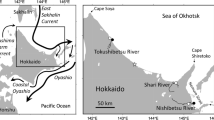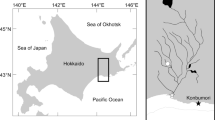Abstract
To examine the efficacy of juvenile salmon research as a tool for forecasting adult returns, the results from a study on the early marine life stage of juvenile chum salmon, conducted in the Nemuro Strait during 1999–2002 (i.e., 1998–2001 brood years), were compared with the return rates of adult salmon. Among the four brood years, the 2000 brood year (i.e., salmon migrating to the sea in 2001) was previously reported as showing higher abundance, higher growth rate and better somatic condition during the coastal residency period. Consequently, we expected it to have the highest return rate, under a hypothesis that juvenile survival in coastal residency regulates brood-year strength. Contrary to this expectation, the 2000 brood year had almost the lowest return rate. Alternatively, a statistical model in which sea surface temperature during the first year of marine life and size at release were utilized as explanatory variables reconstructed the actual variability in return rates more accurately than that based on the early marine life stage. Possible reasons for the discrepancy between the results of the juvenile salmon research and adult returns are discussed, and we suggest improvements for future research on juvenile salmon.





Similar content being viewed by others
References
Beamish RJ (2007) Getting the message out. N Pac Anadr Fish Comm Bull 4:1–6
Schindler DE, Augerot X, Fleishman E, Mantua NJ, Riddell B, Ruckelshaus M, Seeb J, Webster M (2008) Climate change, ecosystem impacts, and management for Pacific salmon. Fisheries 33:502–506
Mantua NJ, Hare SR, Zhang Y, Wallace JM, Francis RC (1997) A Pacific interdecadal climate oscillation with impacts on salmon production. Bull Am Meteorol Soc 78:1069–1079
Intergovernmental Panel on Climate Change (IPCC) (2007) Climate change 2007 synthesis report. IPCC, Geneva
Briscore RJ, Adkison MD (2005) Biophysical factors associated with the marine survival of Auke Creek, Alaska, coho salmon. Trans Am Fish Soc 134:817–828
Greene CM, Jensen DW, Pess GR, Steel EA (2005) Effects of environmental conditions during stream, estuary, and ocean residency on Chinook salmon return rates in the Skagit River, Washington. Trans Am Fish Soc 134:1562–1581
Saito T, Nagasawa K (2009) Regional synchrony in return rates of chum salmon (Oncorhynchus keta) in Japan in relation to coastal temperature and size at release. Fish Res 95:14–27
Parker RR (1968) Marine mortality schedules of pink salmon of the Bella Coola River, central British Columbia. J Fish Res Bd Canada 25:757–794
Healey MC (1982) Timing and relative intensity of size-selective mortality of juvenile chum salmon (Oncorhynchus keta) during early sea life. Can J Fish Aquat Sci 39:952–957
Bax NJ (1983) Early marine mortality of marked juvenile chum salmon (Oncorhynchus keta) released into Hood Canal, Puget Sound, Washington, in 1980. Can J Fish Aquat Sci 40:426–435
Pearcy WG (1992) Ocean ecology of North Pacific salmonids. University of Washington Press, Seattle
Quinn TP (2005) The behavior and ecology of Pacific salmon and trout. University of Washington Press, Seattle
North Pacific Anadromous Fish Commission (2003) A review of the research on the early marine period of Pacific salmon by Canada, Japan, Russia, and the United States. N Pac Anadr Fish Comm Bull 3, Vancouver
Mayama H, Ishida Y (2003) Japanese studies on the early ocean life of juvenile salmon. N Pac Anadr Fish Comm Bull 3:41–67
Hayano H, Asami H, Hirano K (1997) Abundance of micro-animals (especially, Harpacticoid copepods) during the release of juvenile chum salmon, Oncorhynchus keta and adult return rate into the coastal area off Mashike, Japan Sea, northern Hokkaido. Sci Rep Hokkaido Fish Hatch 51:11–16 (in Japanese with English abstract)
Irie T (1990) Ecological studies on the migration of juvenile chum salmon, Oncorhynchus keta, during early ocean life. Bull Seikai Natl Fish Res Inst 68:1–142 (in Japanese with English summary)
Saito T, Shimizu I, Seki J, Nagasawa K (2009) Relationship between zooplankton abundance and marine life history of juvenile chum salmon Oncorhynchus keta in eastern Hokkaido, Japan. Fish Sci 75:303–316
Koo TSY (1962) Age designation in salmon. In: Koo TSY (ed) Studies of Alaska red salmon. University of Washington Press, Seattle, pp 37–48
LeBrasseur RJ, Parker RR (1964) Growth rate of central British Columbia pink salmon (Oncorhynchus gorbuscha). J Fish Res Bd Canada 21:1101–1128
Vila-Gispert A, Moreno-Amich R (2001) Fish condition analysis by a weighted least squares procedure: testing geographical differences of an endangered Iberian cyprinodontid. J Fish Biol 58:1658–1666
Beamish RJ, Mahnken C (2001) A critical size and period hypothesis to explain natural regulation of salmon abundance and the linkage to climate and climate change. Prog Oceanogr 49:423–437
Ueno Y, Ishida Y (1996) Summer distribution and migration routes of juvenile chum salmon (Oncorhynchus keta) originating from rivers in Japan. Bull Nat Res Inst Far Seas Fish 33:139–147
Ueno Y (1998) Distribution, migration, and abundance estimation of Asian juvenile salmon. Salmon Rep Ser 45:83–103
Nagasawa K (2000) Winter zooplankton biomass in the subarctic North Pacific, with a discussion on the overwintering survival strategy of Pacific salmon (Oncorhynchus spp.). N Pac Anadr Fish Comm Bull 2:21–32
Fukuwaka M, Sato S, Takahashi S, Onuma T, Sakai O, Tanimata N, Makino K, Davis ND, Voklov AF, Seong KB, Moss JH (2007) Winter distribution of chum salmon related to environmental variables in the North Pacific. N Pac Anadr Fish Comm Tech Rep 7:29–30
Urawa S (2000) Ocean migration route of Japanese chum salmon with a reference to future salmon research. Natl Salmon Resour Center Newsl 5:3–9 (in Japanese)
Yatsu A, Kaeriyama M (2005) Linkages between coastal and open-ocean habitats and dynamics of Japanese stocks of chum salmon and Japanese sardine. Deep Sea Res II 52:727–737
Burnham KP, Anderson DR (2002) Model selection and multimodel inference: a practical information-theoretic approach, 2nd edn. Springer, New York
National Salmon Resources Center (2000–2003) Database on early life history of Pacific salmon in Japan; Salmon Database 8-11(3). National Salmon Resources Center, Sapporo (in Japanese)
National Salmon Resources Center (2002–2008) Database on biological assessment of Pacific salmon populations in Japan; Salmon Database 10-15(1). National Salmon Resources Center, Sapporo (in Japanese)
Takahashi H (2009) Findings obtained from otolith-thermally marked salmon. FRA Salmon Res Rep 3:6–7 (in Japanese)
Fisher JP, Pearcy WG (2005) Seasonal changes in growth of coho salmon (Oncorhynchus kisutch) off Oregon and Washington and concurrent changes in the spacing of scale circuli. Fish Bull 103:34–51
Kaeriyama M (1989) Comparative morphology and scale formation in four species of Oncorhynchus during early life. Jpn J Ichthyol 35:445–452
Salo EO (1991) Life history of chum salmon (Oncorhynchus keta). In: Groot C, Margolis L (eds) Pacific salmon life histories. USB, Vancouver, pp 231–309
Brett JR (1995) Energetics. In: Groot C, Margolis L, Clarke WC (eds) Physiological ecology of Pacific salmon. USB, Vancouver, pp 1–68
Morita K, Morita SH, Fukuwaka M, Matsuda H (2005) Rule of age and size at maturity of chum salmon (Oncorhynchus keta): implications of recent trends among Oncorhynchus spp. Can J Fish Aquat Sci 62:2752–2759
Nara K (2006) Results of the first five-year program of NASREC. Natl Salmon Resour Center Newsl 16:1–3 (in Japanese)
Wells BK, Friedland KD, Clarke LM (2003) Increment patterns in otoliths and scales from mature Atlantic salmon Salmo salar. Mar Ecol Prog Ser 262:293–298
Moss JH, Beauchamp DA, Cross AD, Myers KW, Farley EV Jr, Murphy JM, Helle JH (2005) Evidence for size-selective mortality after the first summer of ocean growth by pink salmon. Trans Am Fish Soc 134:1313–1322
Karpenko VI (2003) Review of Russian marine investigations of juvenile Pacific salmon. N Pac Anadr Fish Comm Bull 3:69–88
Acknowledgments
We are grateful to the staff of the Nemuro, Ichani and Nijibetsu field stations of NASREC for valuable advice and biological data on adult salmon used in the study. Two anonymous reviewers provided constructive comments that improved the early version of the manuscript.
Author information
Authors and Affiliations
Corresponding author
Rights and permissions
About this article
Cite this article
Saito, T., Shimizu, I., Seki, J. et al. Can research on the early marine life stage of juvenile chum salmon Oncorhynchus keta forecast returns of adult salmon? A case study from eastern Hokkaido, Japan. Fish Sci 76, 909–920 (2010). https://doi.org/10.1007/s12562-010-0286-7
Received:
Accepted:
Published:
Issue Date:
DOI: https://doi.org/10.1007/s12562-010-0286-7




